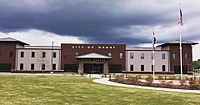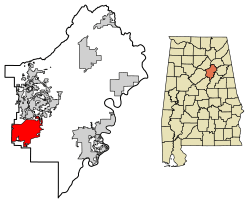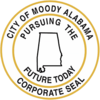Moody, Alabama facts for kids
Quick facts for kids
Moody, Alabama
|
|||
|---|---|---|---|

Moody Civic Center
|
|||
|
|||
| Motto(s):
Pursuing the Future Today
|
|||

Location of Moody in St. Clair County
|
|||
| Country | United States | ||
| State | Alabama | ||
| County | St. Clair | ||
| Incorporated | 1962 | ||
| Founded by | Connor York | ||
| Government | |||
| • Type | Mayor | ||
| Area | |||
| • Total | 24.84 sq mi (64.35 km2) | ||
| • Land | 24.53 sq mi (63.54 km2) | ||
| • Water | 0.31 sq mi (0.81 km2) | ||
| Elevation | 692 ft (211 m) | ||
| Population
(2020)
|
|||
| • Total | 13,170 | ||
| • Density | 536.87/sq mi (207.28/km2) | ||
| Time zone | UTC-6 (Central (CST)) | ||
| • Summer (DST) | UTC-5 (CDT) | ||
| ZIP code |
35004
|
||
| Area code(s) | 205, 659 | ||
| FIPS code | 01-51096 | ||
| GNIS feature ID | 0164758 | ||
Moody is a city in St. Clair County, Alabama. It was founded in 1907 and named after Epps Moody, a local businessman. In 2020, about 13,170 people lived there. Moody is located about 22 miles (35 km) east of Birmingham.
Contents
A Look Back at Moody's History
Moody started as a city in 1907. It got its name from Epps Moody, a businessman from the area.
In its early days, Moody was mostly a farming town. People grew crops like cotton and harvested timber. When the railroad arrived in the early 1900s, Moody began to grow. It slowly became a more industrial city. Today, Moody has many different businesses. These include manufacturing, healthcare, and retail stores.
Moody's Location and Size
Moody is located at 33°35′33″N 86°29′47″W / 33.59250°N 86.49639°W.
The city covers a total area of about 24 square miles (62 square kilometers). Most of this area is land, with a small part being water.
Moody is east of Birmingham. Interstate 20 runs through the southern part of the city. You can get to Moody from exits 144 and 147 on I-20. Downtown Birmingham is about 22 miles (35 km) west. Atlanta is about 127 miles (204 km) east. U.S. Route 411 also goes through Moody. It leads northeast to Ashville and southwest to Leeds.
Who Lives in Moody?
The population of Moody has grown a lot over the years.
- In 1970, there were 504 people.
- By 2000, the population was 8,053.
- In 2010, it grew to 11,726 people.
- The 2020 census counted 13,170 people living in Moody.
Population Details from 2020
As of the 2020 census, there were 13,170 people in Moody. These people lived in 4,930 households. About 3,516 of these were families.
Fun Things to Do in Moody
Moody hosts several events throughout the year. One popular event is the Moody Bluegrass Festival. It features live bluegrass music, arts and crafts, and food.
Other events include the Moody Miracle League Baseball Tournament. This tournament helps raise money for the Miracle League of St. Clair County. The city also has an Annual Christmas Parade.
Learning in Moody
Moody has several schools for students of all ages.
Public Schools
These schools are managed by the St. Clair County Board of Education:
- Moody Elementary School
- Moody Middle School
- Moody Jr. High School
- Moody High School
Private Schools
- Gathering Place Christian Academy—This school teaches students from Pre-Kindergarten to 8th Grade.
- Crossroads Christian School—This is a homeschooling co-op for students from Pre-Kindergarten to 12th Grade.
See also
 In Spanish: Moody (Alabama) para niños
In Spanish: Moody (Alabama) para niños



